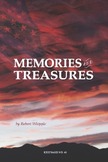Past Presidents 1949-1959
1949 - 1959 : 1960 - 1969 : 1970 - 1979 : 1980 - 1989 : 1990 - 1999 : 2000 - 2009 : 2010 - 2018 : 2020 - 2029
1949 Andy W. Noon
 It was an honor to be president of the first Death Valley ‘49er Encampment.
It was an honor to be president of the first Death Valley ‘49er Encampment.The entire celebration was a free spectacle arranged for the public by the Death Valley ‘49ers, Inc., and the California State Centennial Commission, as one of the State’s official centennial observations.
Film star James Stewart, was narrator for the story of William Lewis Manley and John Rogers, who walked from Death Valley to San Fernando Valley to obtain aid for their comrades stranded here in the winter of 1849-50. The pageant was scheduled to start at 2:00pm, Saturday, December 3, 1949 at Desolation canyon.
By the evening of December 2 it was evident that a far greater crowd than had been anticipated was storming the valley for the centennial events. Almost solid lines of automobiles, bumper to bumper, were strung out along the highways. Overhead, planes circled for landing at the desert airport and the Highway Patrol was trying to cope with the astounding turnout, estimated at 65,000 persons, in the valley.
It was a jovial crowd, camped along the road. The aroma of bacon and coffee filled the air and jokes resounded.
On the great front porch of Furnace Creek Inn, official looked down with awe on the tremendous assemblage.
This was California’s acclaim to the intrepidity of its forebears; its accolade to human courage as expressed in the exploits of the Death Valley party of 1849 and it’s rescuers, Manley and Rogers, who were the heroes of the historical pageant.
All day, out there in the sun, the crowds stayed good-humored despite cars running out of gas, traffic tie-ups, and the failure of many to not reach Desolation Canyon for the performance. Never one word of complaint from man, woman or child, even when the pageant was over and the long shadows of night crawled up the yellow and red flanks of the Funeral Mountains and the wearisome journey home or to dry camp in the desert began. Everybody helped everybody else.
It made everyone proud that an American crowd still could grin at its own discomforts even in the wilderness.
Andy lived in Taft, California and was Chairman of the Board of Supervisors, Kern County. He successfully and proudly held the office of our first president.
Excerpts from article by Ed Ainsworth, staff representative, Los Angeles Times, Dec.1949
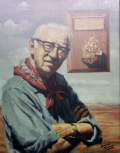 Death Valley and its surroundings were familiar to John Anson Ford a whole generation before 1949. As a Los Angeles public relations man he wrote in the May 1929 American Motorist magazine of an interview with Shorty Harris in 1920, “one of the most widely known of all the old desert men” as John put it. What more appropriate background than a 1920’s interview with Shorty Harris could there have been for the man who, 20 years later, would become the “founder” of the Death Valley ‘49ers. Certainly no person is more deserving of such a title than John Anson Ford.
Death Valley and its surroundings were familiar to John Anson Ford a whole generation before 1949. As a Los Angeles public relations man he wrote in the May 1929 American Motorist magazine of an interview with Shorty Harris in 1920, “one of the most widely known of all the old desert men” as John put it. What more appropriate background than a 1920’s interview with Shorty Harris could there have been for the man who, 20 years later, would become the “founder” of the Death Valley ‘49ers. Certainly no person is more deserving of such a title than John Anson Ford.
In 1948, when funds were appropriated to commemorate California’s Statehood Centennial, John was a member of the Board of Supervisors of Los Angeles County having first been elected to the office in 1934. He was able to lend great influence on behalf of the committee, which had been formed to plan a major celebration to take place in Death Valley the following year.
“They wanted me to be the first president of the organization” John recalled, but he deferred in favor of Andy W. Noon, then Chairman of the Board of Supervisors of Kern County. Kern County along with Inyo, San Bernardino and Los Angeles were the original four sponsoring counties of the Death Valley ‘49ers.
He was elected President in the years 1950 and 1951 to guide the organization’s struggling efforts to continue the encampments as an annual event. By the time he retired from county government the ‘49ers had become the self-supporting organization it is today. In 1960, he was elected to the honorary position of President Emeritus of the Death Valley‘49ers.
The 49ers encampment has truly become one of the great national festivals of America. Their programs have revealed to hundreds of thousands of people the beauty and majesty of Death Valley.
The Twenty-Fifth Annual Encampment was dedicated to John Anson Ford,
latter-day pioneer and visionary, President Emeritus of the Death Valley ‘49ers.He and his lovely wife Lois, lived in their Hollywood Hills home until he
passed away in 1983 at the age of 90.
Excerpts from Eugene Hoffman, ‘49er newsletter
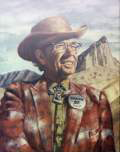 Ardis was born April 9, 1901 in Keyesville, California. His great-grandfather came to California from Texas in 1853 and eventually settled in the Kern River Valley in 1864. As a boy he walked five miles each way to school in Vaughan (now Bodfish). He memorized poetry and would recite it over and over while walking to and from school.
Ardis was born April 9, 1901 in Keyesville, California. His great-grandfather came to California from Texas in 1853 and eventually settled in the Kern River Valley in 1864. As a boy he walked five miles each way to school in Vaughan (now Bodfish). He memorized poetry and would recite it over and over while walking to and from school.
In 1910 his mother took her three sons and one daughter to Fresno so they could get a good education. He graduated from Fresno High and in 1920 entered Fresno Normal College (now California State University, Fresno.) He played on the schools first football, baseball and basketball teams. He gave the school team their nickname: “Bulldogs”. He continued his education at UCLA and later at USC working on and off to pay for his education. He graduated in 1925 with BS in Electric Engineering.
In 1927 Ardis went to work for Bell Telephone Laboratories in New York City, one of the worlds most prestigious research facilities. He worked during the day and wrote poetry at night.
In 1932 he quit Bell and returned to California. He wanted to return to Keyesville, where he was born, and write poetry. That fall, at a dance in Weldon, he met Gayle Mendelssohn. They were married in 1937. Ardis and Gayle complimented each other remarkably well. Ardis would write poetry and books and she would handle all of the details of having them published. They were a couple deeply devoted to each other.
Ardis supplemented his income by being a correspondent for the Bakersfield Californian. In 1938 he ran for Justice of the Peace in Kernville. He was elected, and he and Gayle added another room to their home, which doubled as a courtroom. Gayle became the court clerk. His territory included Ridgecrest and the Naval Ordinance Test Station.
In 1948 he was elected County Supervisor, a position he held for one term and in 1951 Ardis and Gayle built their home in Kernville and continued to make it available for meetings.
Ardis was a conservationist. He had visions that the Kern Plateau had to be protected or it would be lost, and he had the vision long before most people thought of the need for legal protection of land as wilderness area. Congress did not pass the National Wilderness Preservation System until 1964. Ardis recorded 25 trips from 1965-1977 that he and Gayle made.
In the next thirty years he made continuing commitments to establish the Golden Trout Wilderness. He went to Washington to testify in front of the congressional committee in favor of the Endangered American Wilderness in 1977. The bill passed both houses of Congress and was signed by President Carter on February 24, 1978.
Ardis belonged to many organizations but the one he was most committed to was the Death Valley ‘49ers. He was on the Kern County Board of Supervisors along with Andy Noon, his boss, when Governor Earl Warren appointed the original panel to plan the 1949 Pageant. He had a strong influence in shaping its objectives. His sense of history and appreciation of the arts have contributed much to the quality of the Encampment though the years.
In 1953 the Walker’s started a motel in Kernville. He was President of the Kernville Chamber of Commerce at the time “Whiskey Flat Days” was started.
In 1977 the Death Valley Encampment was dedicated to Ardis and Gayle. On September 6th, 1988, after a short illness, Gayle passed away. For the next few years Ardis was quite lonely and eventually went to live with a niece in Bakersfield.
Ardis and Gayle had no children of their own but considered many their “adopted” children. Both had expressed a desire for their home and its furnishings to be kept intact after their deaths. The Walker endowment was created and now makes it possible to visit the only home of a valley historical figure that is intact. With Ardis, we also honor Gayle, his wife, who had been a valuable member of the Walker team. Their contributions have truly been outstanding.
Ardis was made President Emeritus of the Death Valley ‘49ers November 11, 1990, about two months before his death. He passed away January 16, 1991.
Excerpts from 1977 Encampment Program dedicated to the Walkers, by Mary DeDecker, biography by Joseph S. Nelson and the Kern River Valley Historical Society.
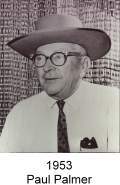 Paul was an Attorney for many years, and as a member of the Death Valley '49ers he served as "Master of Ceremony" at the Dedication of the Visitors Center at Furnace Creek in Death Valley National Monument.
Paul was an Attorney for many years, and as a member of the Death Valley '49ers he served as "Master of Ceremony" at the Dedication of the Visitors Center at Furnace Creek in Death Valley National Monument.
He and his wife, Edith, lived on a Ranch in Newhall California.
Paul passed away in 1968.
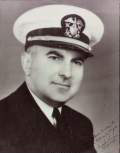 George was the assistant to the publisher of the San Bernardino Sun-Telegram, manager of Inland Printing & Engraving Co. and a widely known Southland civic leader. He was active in nearly every phase of community service. His professional career included top government service, newspaper and administration service.
George was the assistant to the publisher of the San Bernardino Sun-Telegram, manager of Inland Printing & Engraving Co. and a widely known Southland civic leader. He was active in nearly every phase of community service. His professional career included top government service, newspaper and administration service.
He was born in Denison, Iowa, attended high school in Pomona and was graduated from Pomona College in Claremont. Immediately after his graduation, in 1925, he became a member of the Pomona College staff as assistant to the president.
In 1928 he was managing editor of the Claremont Courier and in 1933 became publisher of the Chalfant Press newspaper and four weekly newspapers in Inyo and Mono Counties, including the Bishop Register. In 1946 he became editor and publisher of the South Pasadena Review, and left there to become secretary to the California Highway Commission. He met James Guthrie, President and publisher of the Sun-Telegraph, who persuaded him to join The Sun Co. organization.
He was active in the Boy Scout movement, and served on the council’s executive committee.
He served in the Navy during World War II, retiring with the rank of Lieutenant Commander.
He was very active in the Death Valley ‘49ers, holding the office of production chairman, President and again production chairman for the 1961 Encampment at the time of his death in September 1961.
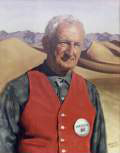 Tom Clements was a professional geologist. He received his degree from the Texas School of Mines and his Doctorate from the California Institute of Technology in Pasadena. He was a geology professor there but soon became head of the department, a position he held for 30 years. During this time he also served as consulting geologist in private practice. In later years he was curator of Mineralogy and Petrology for the Los Angeles County Museum.
Tom Clements was a professional geologist. He received his degree from the Texas School of Mines and his Doctorate from the California Institute of Technology in Pasadena. He was a geology professor there but soon became head of the department, a position he held for 30 years. During this time he also served as consulting geologist in private practice. In later years he was curator of Mineralogy and Petrology for the Los Angeles County Museum.
He met his wife, Lydia, in Chicago during World War I. Tom was there on duty with the Navy. Lydia was a student at the Art Institute. After their marriage, Lydia went with Tom into the fields to paint but soon her own interest in geology developed. Their love of Death Valley began in 1926 when a group from Caltech went there for three days. It was given a major boost in 1950 when Tom took a sabbatical to study the Death Valley desert area. The Superintendent suggested they stay at Cow Creek rather than commute between field trips. They stayed the whole season and became intensely interested in the ancient Indian artifacts on Manly Terrace. They also became acquainted with some of the Indians then living in Death Valley.
Lydia was among the first to paint desert landscapes. She entered her works in early art shows. Lydia’s book “Indians of Death Valley” was published in 1953. She was influential among those who started the ‘49ers Scholarship Fund. Tom’s “The Geological Story of Death Valley” is required reading for any serious Death Valley enthusiast. It was the #1 publication for the ‘49ers. Inside the cover are the words “dedicated most affectionately to my wife, Lydia, true helpmate and constant field companion”.
Dr. Clements passed away May 13th, 1996 at the age of 98. Lydia passed away January 20th, 1994 at the age of 95.
Excerpts from ‘49er newsletter
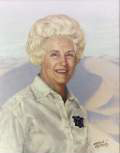 Mrs. Willard J. Lewis, was owner of the Stove Pipe Wells Hotel from 1947 through 1966.
Mrs. Willard J. Lewis, was owner of the Stove Pipe Wells Hotel from 1947 through 1966.
Margaret “Peg” Haviland, Putnam, Lewis took over as sole owner and manager after the death of her husband George Palmer Putnam in 1950.
(George Palmer Putnam’s first wife was Amelia Earhart).
There were many challenges associated with running a hotel in Death Valley, however she met them all, as well as becoming quite active in the Death Valley ‘49er organization.
In 1965 she married Willard Lewis and they decided to sell the hotel. Peg still lives in California and is an Honorary Director of the ‘49ers.
Peg passed away in October 14, 2002
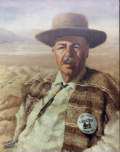 L. Burr Belden, was a well-known San Bernardino editor, author and historian. He was the author of several books, one of which “Goodbye Death Valley” is a ‘49er publication. He authored other works dealing with various phases of desert history and Baja California.
L. Burr Belden, was a well-known San Bernardino editor, author and historian. He was the author of several books, one of which “Goodbye Death Valley” is a ‘49er publication. He authored other works dealing with various phases of desert history and Baja California.
A member on the editorial staff of the San Bernardino Sun-Telegram since 1920, a Marine in World War I, and a history major during his University years, he continued this interest by becoming a founder of both the San Bernardino County Historical Society and The San Bernardino County Museum Association. He was an officer in these groups. He was past President of the Conference of California Historical Societies, Vice President of the Honorable Society of Corporate Historians and a member of the Governor’s California History Commission.
When the Death Valley Museum was planned, he was commissioned by the Department of Interior to write the Historical Survey of the Death Valley region, 1849-1933.
He and his wife Sybil resided in San Bernardino. Both were avid backcountry travelers. Trips in their 4-wheel-drive camper took them into Mexico, Canada’s Arctic and many western Parks. They were active in The American Legion, each having held State Office, and several other patriotic and civic organizations. They had two sons and three grandchildren.
Excerpts from ‘49er newsletter
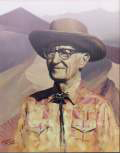 Alex Krater was a true son of those now-vanished and gone forever true west frontier days.
Alex Krater was a true son of those now-vanished and gone forever true west frontier days.
Born in Ibex, California, he soon moved with his family to the booming copper-mining town of Jerome, Arizona. With the decline of Jerome, the family returned to California. When only a boy, Alex came to Independence to work for his older brother, Frank. Independence then was very much a Frontier town and the “wide open spaces” were very wide and very open. After living in Reno for a time and serving in World War I, he returned to Independence.
Excerpts from ‘49er newsletter
 Harold was known around Pasadena as a “Big Wheel” in furniture, (owner of a large department store) but up in Death Valley he was the man who would scale Telescope Peak or explore the Racetrack Valley at every opportunity.
Harold was known around Pasadena as a “Big Wheel” in furniture, (owner of a large department store) but up in Death Valley he was the man who would scale Telescope Peak or explore the Racetrack Valley at every opportunity.
For the 1958 Encampment he led an off-the-beaten-path excursion for the hardy, adventuresome visitors who came with jeeps, pickups or other high centered-vehicles.
Who knows what the destination was? Maybe Ubehebe ghost towns, Gold Belt Spring, Saratoga, Owls Hole, Butte Valley or Wingate Wash. Maybe Harold would let the participants decide.
I bet it was an exciting day of adventure and many places were seen that most ‘49ers had never been to.
He was a real adventurer. Harold passed away in 1984.
Excerpts from ‘49er newsletter


